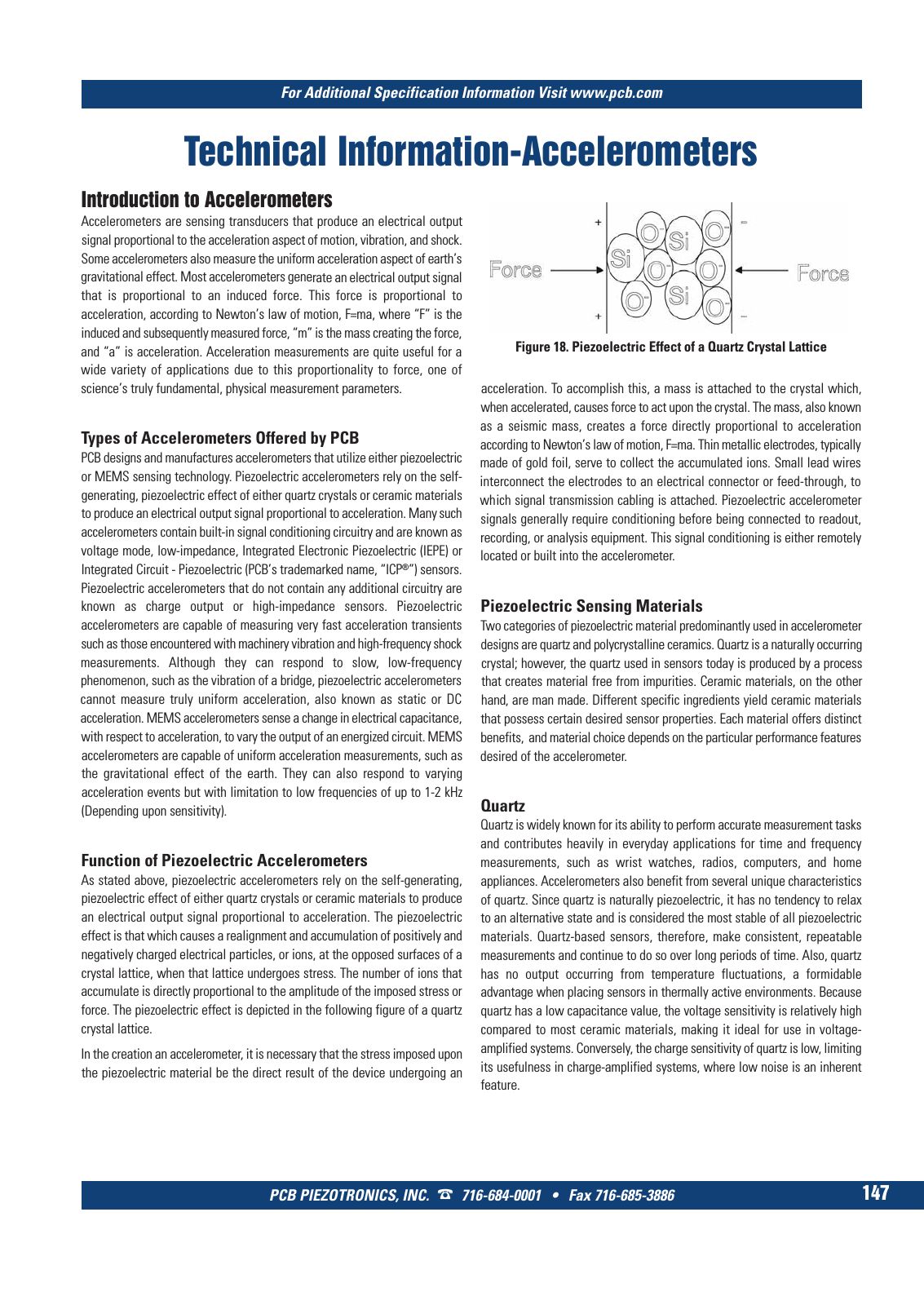PCB Test & Measurement Seite 149
Hinweis: Dies ist eine maschinenlesbare No-Flash Ansicht.Klicken Sie hier um zur Online-Version zu gelangen.
Inhalt
For Additional Specification Information Visit www pcb com PCB PIEZOTRONICS INC 716 684 0001 Fax 716 685 3886 147 Technical Information Accelerometers Introduction to Accelerometers Accelerometers are sensing transducers that produce an electrical output signal proportional to the acceleration aspect of motion vibration and shock Some accelerometers also measure the uniform acceleration aspect of earth s gravitational effect Most accelerometers generate an electrical output signal that is proportional to an induced force This force is proportional to acceleration according to Newton s law of motion F ma where F is the induced and subsequently measured force m is the mass creating the force and a is acceleration Acceleration measurements are quite useful for a wide variety of applications due to this proportionality to force one of science s truly fundamental physical measurement parameters Types of Accelerometers Offered by PCB PCB designs and manufactures accelerometers that utilize either piezoelectric or MEMS sensing technology Piezoelectric accelerometers rely on the self generating piezoelectric effect of either quartz crystals or ceramic materials to produce an electrical output signal proportional to acceleration Many such accelerometers contain built in signal conditioning circuitry and are known as voltage mode low impedance Integrated Electronic Piezoelectric IEPE or Integrated Circuit Piezoelectric PCB s trademarked name ICP sensors Piezoelectric accelerometers that do not contain any additional circuitry are known as charge output or high impedance sensors Piezoelectric accelerometers are capable of measuring very fast acceleration transients such as those encountered with machinery vibration and high frequency shock measurements Although they can respond to slow low frequency phenomenon such as the vibration of a bridge piezoelectric accelerometers cannot measure truly uniform acceleration also known as static or DC acceleration MEMS accelerometers sense a change in electrical capacitance with respect to acceleration to vary the output of an energized circuit MEMS accelerometers are capable of uniform acceleration measurements such as the gravitational effect of the earth They can also respond to varying acceleration events but with limitation to low frequencies of up to 1 2 kHz Depending upon sensitivity Function of Piezoelectric Accelerometers As stated above piezoelectric accelerometers rely on the self generating piezoelectric effect of either quartz crystals or ceramic materials to produce an electrical output signal proportional to acceleration The piezoelectric effect is that which causes a realignment and accumulation of positively and negatively charged electrical particles or ions at the opposed surfaces of a crystal lattice when that lattice undergoes stress The number of ions that accumulate is directly proportional to the amplitude of the imposed stress or force The piezoelectric effect is depicted in the following figure of a quartz crystal lattice In the creation an accelerometer it is necessary that the stress imposed upon the piezoelectric material be the direct result of the device undergoing an acceleration To accomplish this a mass is attached to the crystal which when accelerated causes force to act upon the crystal The mass also known as a seismic mass creates a force directly proportional to acceleration according to Newton s law of motion F ma Thin metallic electrodes typically made of gold foil serve to collect the accumulated ions Small lead wires interconnect the electrodes to an electrical connector or feed through to which signal transmission cabling is attached Piezoelectric accelerometer signals generally require conditioning before being connected to readout recording or analysis equipment This signal conditioning is either remotely located or built into the accelerometer Figure 18 Piezoelectric Effect of a Quartz Crystal Lattice Piezoelectric Sensing Materials Two categories of piezoelectric material predominantly used in accelerometer designs are quartz and polycrystalline ceramics Quartz is a naturally occurring crystal however the quartz used in sensors today is produced by a process that creates material free from impurities Ceramic materials on the other hand are man made Different specific ingredients yield ceramic materials that possess certain desired sensor properties Each material offers distinct benefits and material choice depends on the particular performance features desired of the accelerometer Quartz Quartz is widely known for its ability to perform accurate measurement tasks and contributes heavily in everyday applications for time and frequency measurements such as wrist watches radios computers and home appliances Accelerometers also benefit from several unique characteristics of quartz Since quartz is naturally piezoelectric it has no tendency to relax to an alternative state and is considered the most stable of all piezoelectric materials Quartz based sensors therefore make consistent repeatable measurements and continue to do so over long periods of time Also quartz has no output occurring from temperature fluctuations a formidable advantage when placing sensors in thermally active environments Because quartz has a low capacitance value the voltage sensitivity is relatively high compared to most ceramic materials making it ideal for use in voltage amplified systems Conversely the charge sensitivity of quartz is low limiting its usefulness in charge amplified systems where low noise is an inherent feature 9 T Mcatalog 2011 Seite 125 166 SYN G500 21 04 11 18 04 Seite 153
